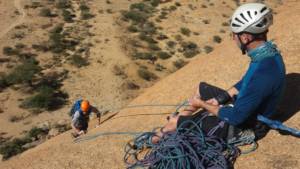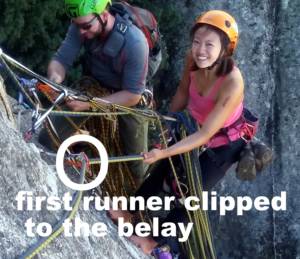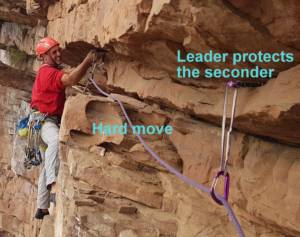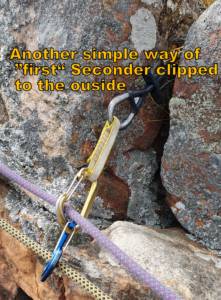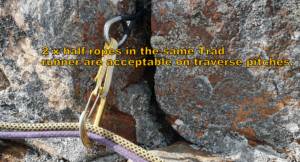- It’s all about management of belays and ropes and fellow climbers.
Climbing long multi-pitch routes require different techniques and sequences depending on the total numbers of people and the numbers of lead climbers in a rope. Often on multi-pitch climbs, there is lots of time wasted, because members do not understand how to manage the belays.General skills
– It is always inefficient for a lead climber to arrive at a stance and use the ropes to build the belay anchor, as this means that the ends of that rope cannot be used by others in the party to lead the next pitch. It also means that members have to do a lot of untying and retying of ropes and clipping on and off with cow’s tails or slings. In most cases there must be at least 2 x cordellettes per party, which are used to build the belay anchor with a Master-point. It is onto the Master-point that the entire party belays off or clips to when waiting to climb. The ropes then are never used to build the anchor, except in the first instance shown below or when the final pitch is reached.
– In climbing parties of 2 climbers where both will lead alternative pitches, the belay anchor can be built out of the ropes.
– In a party of 2 climbers where only one person is doing the leading, carry 2 x
cordellettes to be used at each stance to build the belay.
– In parties of 2-4 people with one or more lead climbers, the person scheduled to climb the next pitch, is always the first person to second the pitch, and as they climb, they must remove the protection, and as far as possible place it on their harness, already racked for their lead. This saves time at the stance before the next pitch.
– If in a party of 3, the first seconder can remove the protection from the third man’s rope, unless it is needed for protection in the case of a traverse.
– All lead climbers must start their pitch with a cordellette rolled neatly up and carried on their harness, ready for the next stance.
– In the case of multi-pitch Sport climbs where 2 bolts form a belay or abseil station, instead of a cordellette the party can use a 120cm sling to equalise the belay between the bolts and belay from the Master-point.
– All the lead climbers can carry a copy of the route description, so it can be studied before each pitch or even while climbing. This saves time as the group seldom goes off route and the stance is put in the correct place.
– In the case where a pitch ends on a wide ledge and the next pitch starts a few metres away, the lead climber can simply walk to the next stance and belay from there.
– On many climbs it is possible to link short pitches together in one long pitch and thereby save time.
– Where it is possible and safe to do so, the leader can bring two seconds up at the same time, climbing one behind each other. It is best in these situations using a “Reverso“ type belay device in the “Guide Mode”.
– Depending on the nature of the climb, keep rucksacks as small as possible.
– Try to avoid rucksack hauling, as it is a very time consuming way to climb.
For more information on a course like the MDT Multi- Pitch Supervisor Course contact gavin@peakhigh.co.za
